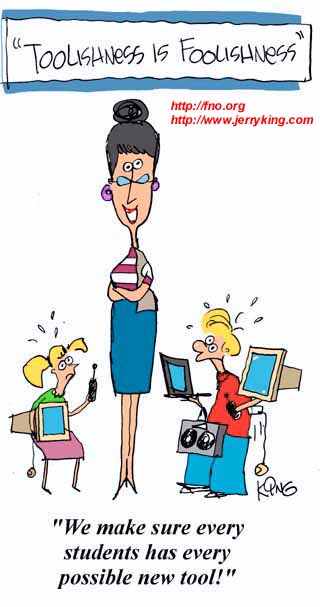Order McKenzie books online with a credit card
Bring Jamie to your school or district for a great workshop
September Issue
Vol 29|No 1|September 2018

© iStock.com
Looking back and looking forwardJust how big an educational revolution resulted
By Jamie McKenzie (about author)
When microcomputers first came to school
Half a century has passed since I first tasted how computers might change schools for the better. In 1968 I was teaching English and social studies in a private school in Connecticut that had the foresight to connect with the mainframe at the University of Bridgeport. Being a fan of simulations to bring historical decision-making to life for students, I hoped computers might help them to see the consequences of their choices. But I had to wait a few more years. This was a time of great exploration in schools with "open classrooms," "schools without walls" and what was called "The New Social Studies" — an approach that focused on inquiry learning but failed to win broad acceptance from social studies teachers across the land. By 1980, Tom Snyder Productions, began producing the kinds of simulations I had in mind and those are still available and powerful today — "Decisions, Decisions!" Before that, in 1978 while an elementary principal in New Jersey, we bought two Apple "microcomputers" for the school, and before long we were testing their potential full on, teaching students to program in Basic and wondering how they might best support student thinking, problem-solving and invention. During a summer workshop at Columbia Teachers College at that time I attended with colleagues from our three elementary schools, the most powerful idea presented was the capacity of computers to "crunch numbers" in ways to make sense of huge databases. It was an idea that did not catch on quickly in the K-12 world. Two Main Views of Computers in ClassroomsThe educational world swiftly divided into two camps: those who saw computers as tools to support thinking and exploration and those who saw them as teachers or babysitters. Sadly, it was the second group that seized the day. Even within the camp that emphasized thinking, there was an unwarranted belief, subsequently discredited, that if students learned to program on computers, they would gain thinking skills that would transfer into other domains. Some of us then spent several years showing students how to program turtles to move about on a screen, using Logo, which MIT's Seymour Pappert had lauded in his book — Mindstorms: Children, Computers, and Powerful Ideas — in which he argued for the benefits of teaching computer literacy in primary and secondary education. His ideas were theoretically exciting, but few of the benefits he predicted ever materialized. During this past half century, in contrast with the excellent simulations produced by the Tom Snyder group, many of the products and programs sold to schools with grand promises proved wasteful and disappointing. We saw "drill-and-kill" software promoted ad nauseam at great cost with paltry results. We saw edutainment and frivolity. Then we had "surfing the Net" in the 1990s — which offered little more than browsing through information that was often unreliable. During these decades, a huge amount was spent on equipment and then networking, with little investment in professional development or program development. This inspired me to comment that "Toolishness is foolishness!"
Despite a lack of evidence to support the notion that laptopping both students and schools would enhance their thinking, writing and overall performance, one-on-one computing became fashionable. It was not uncommon to sit at a conference and hear impressive claims that were never substantiated.
As we entered a new century, laptopping schools was all the rage with technology companies like Microsoft trumpeting the benefits at conferences. As I outlined in 2002 in "After Laptop," many of the first experiments with one-on-one computing failed to produce the promised benefits.
And now?
© iStock.com What evidence do we have of great results?
In the USA we can look at "The Nation's Report Card" -- "The National Assessment of Educational Progress (NAEP), first administered in 1969, is the largest continuing and nationally representative assessment of what our nation’s students know and can do in subjects such as mathematics, reading, science, and writing. Standard administration practices are implemented to provide a common measure of student achievement."
Capacity Building Improvement in student performance requires a substantial investment in professional development to change the way teachers work with students. It is not enough to lift standards, introduce tougher tests and buy lots of laptops. A 2017 article in the LA Times reported that California scores on new tests tied to the Common Core Standards seemed to have flattened out or stagnated in the second and third years, as if some had hoped the tests themselves would have led to improvements. One observer wisely commented that it takes more than tests to change performance:
Diane Ravitch, once a supporter of high stakes testing and the Common Core Standards, has come to challenge this approach to school improvement, as she argued in her July, 2016 New York Times article, "The Common Core Costs Billions and Hurts Students."
How teachers learn technology I have been arguing since the 1990s that robust staff development is required if we hope to see teachers make smart use of new technologies in order to improve student thinking, problem-solving and performance.
The article and the strategies suggested remain just as pertinent (and ignored) today as they were when published, as funding flowed to equipment rather than adult learning. In a related March 2003 article -- "The True Cost of Ownership" -- I pointed out the need to fully fund the introduction of any innovation, identifying all key elements required for success.
This model would apply for the introduction of new technologies as well as something like implementing the Common Core Standards. Sadly, the wisdom of this approach is usually ignored by change agents who rush things and cut many corners as well as key investments. Some of the worst damage has been done by so-called philanthropists imposing simplistic changes on schools that are poorly implemented. They often try to impose change strategies from the business world that show a shocking ignorance of schools, teachers, learning and the best strategies to create growth and improvement. What can any one school or school district do?When a school makes student thinking, problem-solving and questioning a priority, and when that school invests heavily in professional development designed to equip all teachers with the strategies most likely to nurture such thinking, performance will improve in ways that are measurable and dramatic. But this kind improvement involves a commitment of 3-5 years, with peer coaching and sustained adult learning customized to match the learning styles and readiness levels of each teacher. Back in the 1980s and 1990s, some excellent models for teacher growth were developed by educational researchers such as Bruce Joyce, Beverly Showers and Sprinthall and Sprinthall. These models remain pertinent today, but most of them have been shoved aside in many places where high stakes testing has imposed a test-driven change agenda. Many of the strategies proven effective back then are summarized in my article, "Designing Staff Development for the Information Age." That article suggests the following key elements:
It is quite clear that the wisdom and research of the 1980s and 1990s was pretty much ignored by so-called reformers in the last two decades. Here and there, wise school leaders kept the faith, investing in robust professional development that empowered teachers, bringing models like Habits of Mind and the International Baccalaureate program to life in their classrooms. Moving to Proficiency and BeyondA close examination of what is meant by "proficiency" on the Nation's Report Card for a category like writing clarifies the challenge involved in helping the majority of students in one school past proficiency to the advanced level of performance. It is this challenge that inspired my two most recent books.

To honor the values and strategies for effective professional development outlined above, a school wishing to produce great movement to the proficient level and beyond would design activities for the teaching staff that would engage them in the kinds of thinking and writing activities outlined in these two books — a journey that might take 5-10 days spread out over two years. It is not enough to equip students with laptops or tablets. The secret to the powerful use of laptops for writing and thinking is an understanding of incubation, percolation, fermentation, reverie and idea processing. Unless the staff has actively experienced and embraced these concepts and processes in a well-designed adult learning experience, it is unlikely the students will show much growth. 
|
Written materials, art work and photography on this site are copyrighted by Jamie McKenzie and other writers, artists and photographers. Written materials on these pages may be distributed and duplicated if unchanged in format and content in hard copy only by school districts and universities provided there is no charge to the recipient. They may also be e-mailed from person to person. All other uses, transmissions and duplications are prohibited unless permission is granted expressly. Showing these pages remotely through frames is not permitted. FNO is applying for formal copyright registration for articles.
|






